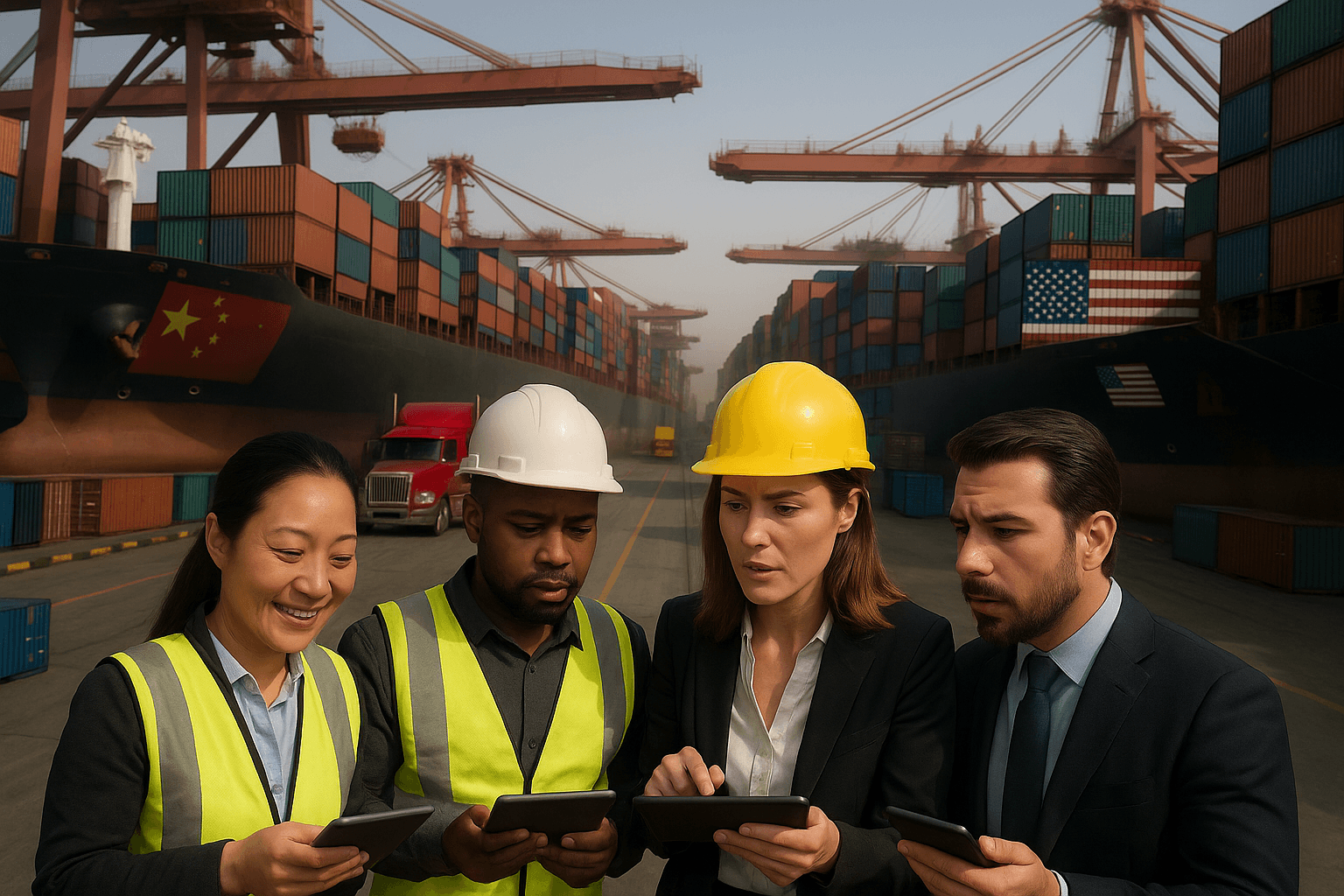
Transload in Chicago, IL: Unlocking New Supply Chain Profits in the Next Decade
How Chicago’s transload services unlock supply chain profits and reduce logistics costs.
Freitty
18 May 2025, 13 min read
Introduction: Transload in Chicago, IL as a Strategic Advantage
Transload in Chicago, IL has become one of the most powerful logistical strategies driving modern supply chains. For businesses looking to adapt to dynamic market demands, rising freight costs, and increasingly complex distribution networks, transload presents not just a solution but a long-term competitive advantage. By transferring goods between rail, truck, and air with speed and efficiency, companies can optimize costs, increase delivery speeds, and expand their market reach. Chicago’s unique logistical geography transforms transload from an operational tactic into a high-impact business strategy with measurable financial gains over the next decade.
Why Chicago is America’s Transload Powerhouse
Chicago isn’t just a logistics hub—it’s the backbone of American freight flow. With unmatched infrastructure, intermodal connections, and a workforce specialized in complex logistics, Chicago stands as the undisputed transload capital of North America.
• Central Access to Major U.S. Markets: Chicago connects to more than 70% of North American consumers within two days, enabling swift distribution across East, West, and South.
• Six Class I Railroads: No other city in the U.S. matches Chicago’s rail capacity, creating unparalleled efficiencies in transferring bulk and containerized freight.
• O’Hare International Airport Access: For time-sensitive shipments, Chicago pairs rail and truck transload operations with international air cargo links.
• Thousands of Industrial Facilities: Chicago offers vast options from traditional transload yards to modern, automated distribution hubs.
• Expert Workforce and Logistics Culture: Generations of freight expertise and a deep professional pool give businesses access to industry-leading operational excellence.
Chicago’s logistics advantage is comprehensive: location, infrastructure, workforce, and innovation.
Transload Benefits for Businesses in 2025–2035
Transload in Chicago is a direct answer to the top pain points businesses will face through 2035—rising transportation costs, demand volatility, and the pressure to serve markets faster.
• Optimized Freight Spending: Companies save up to 40% on long-haul transportation by combining cost-effective rail with nimble last-mile trucking.
• More Responsive Supply Chains: Transload allows for flexible stock positioning, making it easier to shift products in response to changing market conditions.
• Acceleration of Time-to-Market: Skip slow-moving ports and congested coastal routes by using Chicago as a distribution nerve center.
• Improved Cash Flow: Reduced reliance on long-term warehousing means lower inventory costs and more capital freed for growth initiatives.
• Higher Margins through Operational Efficiency: From agriculture to e-commerce, every sector benefits from the ability to serve more markets faster and cheaper.
In a decade shaped by supply chain challenges, transload becomes the profitability lever businesses cannot ignore.
Regional Growth and Economic Expansion through Transload
Beyond corporate efficiency, transload is a force multiplier for Chicago’s regional economy, accelerating job creation, industrial redevelopment, and innovation.
• High-Quality Job Creation: From logistics managers to truck operators and warehouse tech specialists, transload growth fuels broad employment.
• Urban and Industrial Renewal: Underutilized industrial corridors are revived into cutting-edge logistics districts, increasing regional productivity.
• Infrastructure Investment: Public and private funds flow into transportation upgrades, modern terminals, and smart highways around transload hubs.
• Strengthened Export Capacity: By simplifying access to export lanes, Chicago enables regional manufacturers and farmers to thrive in global markets.
• Innovation Ecosystem Expansion: Startups in freight-tech, warehouse robotics, and predictive logistics choose Chicago due to its transload ecosystem.
The economic ripple effects from Chicago’s transload expansion will continue growing for decades.
5, 10, and 15-Year Supply Chain Outlook in Chicago
Transload in Chicago is not static—it’s evolving into a highly automated, tech-enhanced ecosystem that will redefine logistics efficiency in the next decade and beyond.
• 5-Year Outlook: Smart scheduling, automated cranes, and predictive analytics will streamline daily operations, reducing transfer times and costs.
• 10-Year Outlook: Widespread integration of renewable energy, electric freight vehicles, and intelligent routing will make Chicago a model for green logistics.
• 15-Year Outlook: Fully autonomous freight flows, AI-managed terminals, and next-gen rail-to-truck integrations will become industry norms in Chicago.
Early adopters will be best positioned to capitalize on these technological shifts, making now the optimal time to invest in transload.
Cost Savings and Financial Efficiency of Transload Operations
Transload doesn’t just make logistics faster—it dramatically improves the financial performance of supply chains.
• Significant Reduction in Freight Costs: Optimized rail and truck combinations consistently outpace traditional full-truckload shipping savings.
• Lower Fixed Infrastructure Costs: Companies avoid long-term warehouse leases by using transload for dynamic inventory flows.
• Fewer Inventory Losses and Damages: With advanced cargo tracking and careful transfer processes, companies minimize loss rates.
• Faster Product Cycles: Reduced delays enable quicker product turnover, better market responsiveness, and healthier cash cycles.
• Higher Return on Supply Chain Investment: The compounding effect of cost savings, reduced lead times, and minimized inventory risks result in superior ROI.
In competitive industries, transload enhances both profitability and financial agility.
Technology Trends in Chicago Transload Facilities
Chicago’s transload sector is embracing rapid technological evolution, setting global benchmarks for smart logistics.
• AI and Machine Learning: Predictive models optimize load planning, route efficiency, and resource allocation.
• Internet of Things (IoT): Real-time monitoring ensures visibility across multimodal shipments, reducing errors and theft risks.
• Automation and Robotics: High-speed cranes, robotic forklifts, and AI-assisted scheduling make transfers faster and more precise.
• Blockchain Transparency: Secure digital ledgers streamline cross-border customs and create verifiable transaction records.
• Sustainable Technologies: Green terminals powered by solar, wind, and energy-efficient systems are reducing environmental impact.
Businesses that align with Chicago’s tech-forward logistics ecosystem will enjoy long-term operational resilience.
Why More Regions Should Adopt Transload Solutions
Chicago offers a blueprint for other regions to transform their logistics landscapes and stimulate local economies.
• Reduce National Bottlenecks: Inland transload reduces pressure on overburdened coastal ports.
• Strengthen Domestic Trade: Efficient transload supports better regional trade flows, especially in growing Midwest and Southern markets.
• Build Resilient Supply Chains: Transload hubs offer alternative routes during global disruptions or domestic capacity shortages.
• Generate Economic Multipliers: Every transload project brings jobs, infrastructure, and community growth.
• Promote Industrial Modernization: Reviving outdated industrial districts with modern logistics centers boosts broader economic revitalization.
More regions adopting transload means a healthier, more competitive American logistics network.
Transload’s Role in ESG and Sustainable Logistics
Sustainability is no longer optional. Transload positions companies to achieve their environmental goals while improving logistics performance.
• Lower Emissions Footprint: By shifting freight to rail, businesses immediately reduce CO2 emissions.
• Cleaner Cityscapes: Less urban trucking means quieter, cleaner cities.
• Green Building Designs: Many Chicago transload hubs use LEED-certified buildings and renewable power.
• Support for Circular Logistics Models: Efficient returns and redistribution channels cut waste.
• Positive Investor Relations: ESG-conscious investors increasingly value businesses with transparent, efficient, and green supply chains.
Transload merges sustainability with business efficiency—a rare synergy in today’s market.
Strategic Takeaways for Decision Makers
For executives crafting future-ready logistics strategies, the message is clear:
• Use Chicago’s transload capacity to cut logistics costs and reach markets faster.
• Leverage dynamic transload models instead of investing in rigid infrastructure.
• Integrate next-gen supply chain technologies through Chicago’s evolving logistics ecosystem.
• Meet ESG goals without compromising on profitability or speed-to-market.
• Position your business for 2030 and beyond with smarter, more agile, and greener logistics.
Transload in Chicago is a growth engine—profitable today, sustainable tomorrow, and indispensable for long-term competitiveness.
You may also like

Logistics Without Limits: How Franchising Is Fueling the Next Wave of Growth in the Industry
A New Era of Scalable, High-Performance Logistics
4 min read

Bridging Giants: Navigating the US-China Supply Chain in a Shifting Global Landscape
Unlocking Opportunities Amidst Geopolitical Change
0 min read

Unlocking Value Together: How the Sharing Economy Is Reshaping Logistics and Beyond
The New Age of Shared Value
0 min read
Streamline Your Logistics Today
Partner with Freitty for smarter, faster, and more efficient cross-docking services.
